Published on 19/02/2021
Updated on 03/03/2023 (IST 20:30 hrs)
- License CC BY-SA 4.0
COMPILED BY DEBAPRASAD BANDYOPADHYAY AND AKHAR BANDYOPADHYAY
VIEW IT AT:
“The whole world says that all the crooks in India deposit their money in banks abroad. Black money is hoarded in banks abroad. My brothers and sisters of Kanker, tell me, this stolen money should come back or not? This black money should come back or not? Shall we take back every penny hoarded by these crooks? Doesn’t the public have a right over this money? Should this money not be utilised for the benefit of the public?” “If even once, the money hoarded by these crooks in banks abroad, even if we bring only that back, every poor Indian would get free of cost Rs 15 to Rs 20 lakhs, just like that. There’s so much money.”
–Narendra Modi
Public rally on November 7, 2013 in Chhattisgarh’s Kanker.
VIEW HERE ⤡(As reported by ©The Boom)
I. THE BACKGROUND: DHFL SCAM AT A GLANCE VIEW HERE ⤡
II. CRONY CAPITALISM IN CONTEMPORARY INDIA
The quest of business tycoons for politico-economic power leads to funding of the political parties (limited companies!). Politicians rely on businessmen to fund their electoral campaigns. On the other hand, getting backed by the richest tycoon in the country can make all the difference that a politician needs to win the elections. After winning the election, the politician would return some benefits to the business tycoons by giving him tax leeway, special benefits etc. That is, donor-receptor’s conditional relationship is very much important here. This is the regime of crony capitalism.

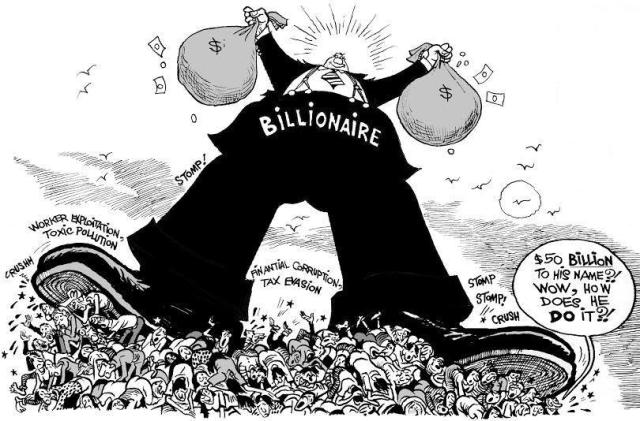
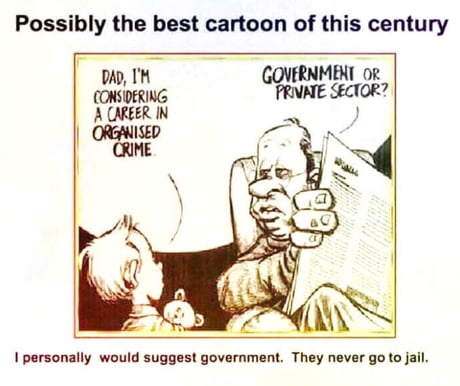
According to The Economist (2016 based on the work by Ruchir Sharma of Morgan Stanley Investment Management, Aditi Gandhi and Michael Walton OEW Delhi’s Centre for Policy Research, and others” in 2014), India occupied the ninth position in the global Crony-Capitalist Index, having crony sector wealth that accounts for 3.4% of the total GDP. VIEW HERE ⤡ (As reported on MAY 09, 2016 ©Hindustan Times). Following empirical evidences are more than enough to prove that the citizens of India are under the regime of crony capitalists.
Thus the voters, as consumers of the election industry, are electing their governments by giving dollar votes.
UPDATED-ANALYSIS OF INCOME & EXPENDITURE OF NATIONAL POLITICAL PARTIES FOR FY 2018-19 VIEW HERE ⤡ (as reported on 25th June 2020) ©Association for Democratic Rights in India (ADR)


ANALYSIS OF ASSETS & LIABILITIES OF NATIONAL PARTIES– FY 2016-17 and 2017-18 VIEW HERE ⤡ (as reported on 31 Jul 2019 © Association for Democratic Rights in India ADR)
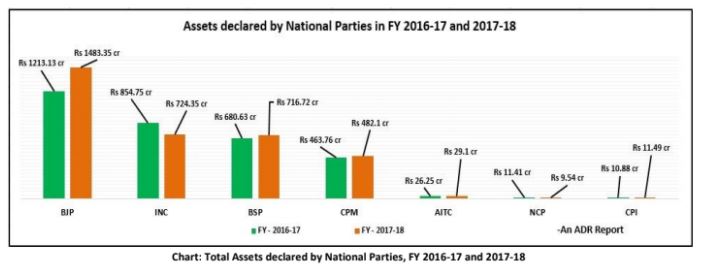
ANALYSIS OF DONATIONS FROM CORPORATE & BUSINESS HOUSES TO NATIONAL POLITICAL PARTIES FOR FY 2018-19 (KNOWN DONATIONS ABOVE RS 20,000 ONLY) VIEW HERE ⤡ (as reported on 20 Nov 2020 © Association for Democratic Rights in India ADR)
Rs 13.33 cr or 99.75% of such donations without PAN as well as address details worth Rs 13.364 cr belong to the BJP.

1. BJP’s Declared Assets Increased By 627% in 10 Years: ADR Report VIEW HERE ⤡ (as reported on October 17 2017 © BloombergQuint)
2. BJP highest earner in FY19 at Rs 2,410 crore; TMC’s income spikes 3,628% VIEW HERE ⤡(as reported on January 16, 2020 © BusinessToday)
3. BJP’s assets increased by 22% in 2017-18, Congress’ down by 15%: ADR VIEW HERE ⤡ (as reported on 01 Aug 2019 © Economic Times)
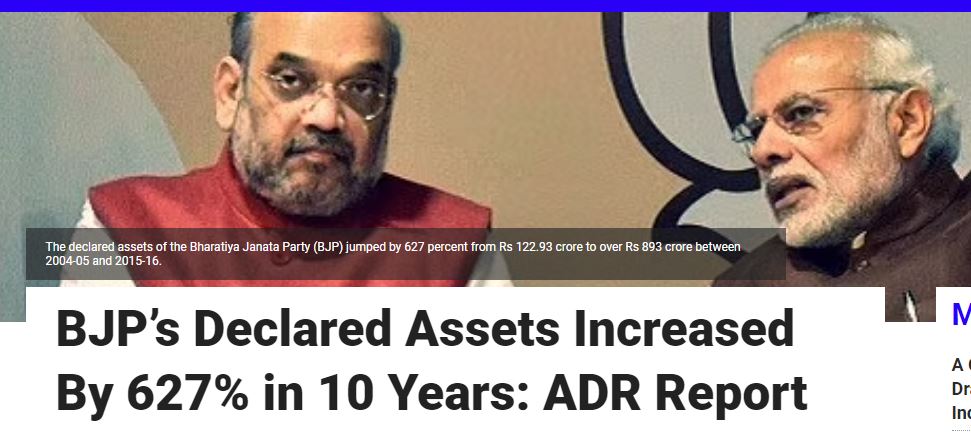
Following report of the Cobrapost alleged that political donations (as expected in the crony capitalist scenario) worth crores of rupees to the Bharatiya Janta Party (BJP), in violation of Section 182 of Companies Act, 2013 for political donations.
DEWAN HOUSING FINANCE CORPORATION LIMITED- THE ANATOMY OF INDIA’S BIGGEST FINANCIAL SCAM VIEW HERE ⤡ (as reported on January 29, 2019 ©Cobrapost)
Even, it is alleged that in case of individual party member is also gaining through nepotism, e.g.,
Amit Shah’s Son Delayed Filings, His Total Income Rose By 15000% From 2014-19: Report VIEW HERE ⤡ (As reported on 5 Nov 2019 ©The Logical Indian)
Amit Shah’s son’s ₹6 crore company got credit facility worth ₹97 crore, says Congress VIEW HERE ⤡ (As reported on11 Aug 2018, ©National Herald)
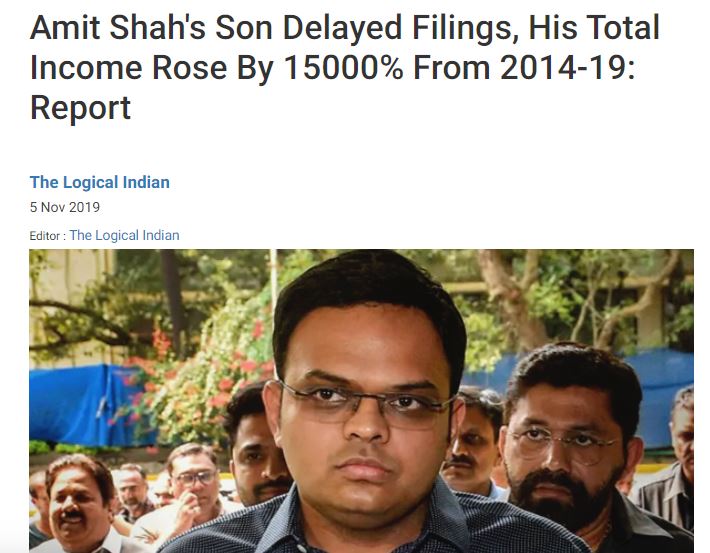
However, the DHFL FD Holders ⤡ are in big trouble due to the crony and monopoly capitalist ventures of the present regime.
Mrs. Nirmala Sitharaman has opposed such branding, quite contrary to her husband’s allegations VIEW HERE ⤡:
a) ‘Not working for damaads’: FM Nirmala Sitharaman fires back at Congress over ‘crony capitalists’ jibe VIEW HERE ⤡ (as reported on Feb 12, 2021 ©Times Now) .
b) ‘Who takes Mudra loans, damaads?’ Sitharaman’s dig at opposition over crony capitalism remark VIEW HERE⤡ (as reported on Feb 12, 2021©Times Of India)
c) PM Modi works for common people not for crony capitalists, says FM Nirmala Sitharaman in Lok Sabha VIEW HERE⤡ (as reported on 13 February, 2021©Deccan Herald).
Nirmala Sitharaman’s statements lack explanatory adequacy as it is merely a descriptive listing of governmental welfare policies based on the dole economy without solid empirical evidences. By concealing the facts of business tycoons-political parties’ donor-receptor collusion, she was just giving lip-services for her government. Paradoxically enough, the DHFL, it is alleged, is plan fully going to be handed over to the father-in-law of a damaad (son-in-law) of a business tycoon, a close associate of the ruling party, in a throwaway price by depriving all of its investors including shareholders, NCD-Holders, FD-holders.
How can all it be done without cronies?
Not only that, the scenario is bleaker. PSU banks, some private banks are going to get bankrupted due to Gross NPAs. Inflation is inevitable. One peculiar instance:
A. Loans over Rs 68k crore, including to Mehul Choksi’s firms, VIEW HERE⤡
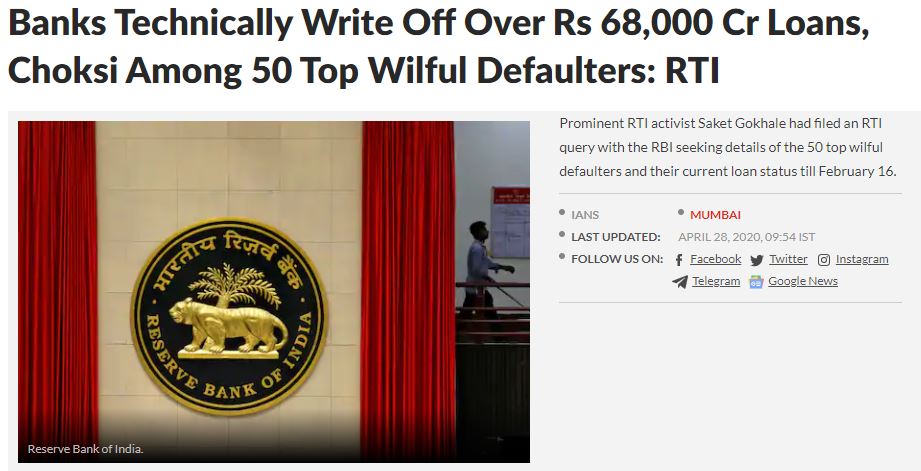

On the contrary DHFL investors are suffering for the non-payments of their dues, which are not debts.
III. MONOPOLY CAPITALISM/OLIGARCHY
“India’s position is similar to America’s Gilded Age, with Ambani and Adani like the modern day Rockefellers and Vanderbilt…The risk is India creates a class of entrenched business oligarchs.”
Associate professor, National University of Singapore and author of The Billionaire Raj: A Journey Through India’s New Gilded Age (2018), (As reported on Dec 15, 2020 VIEW HERE ⤡ ©Economic Times)

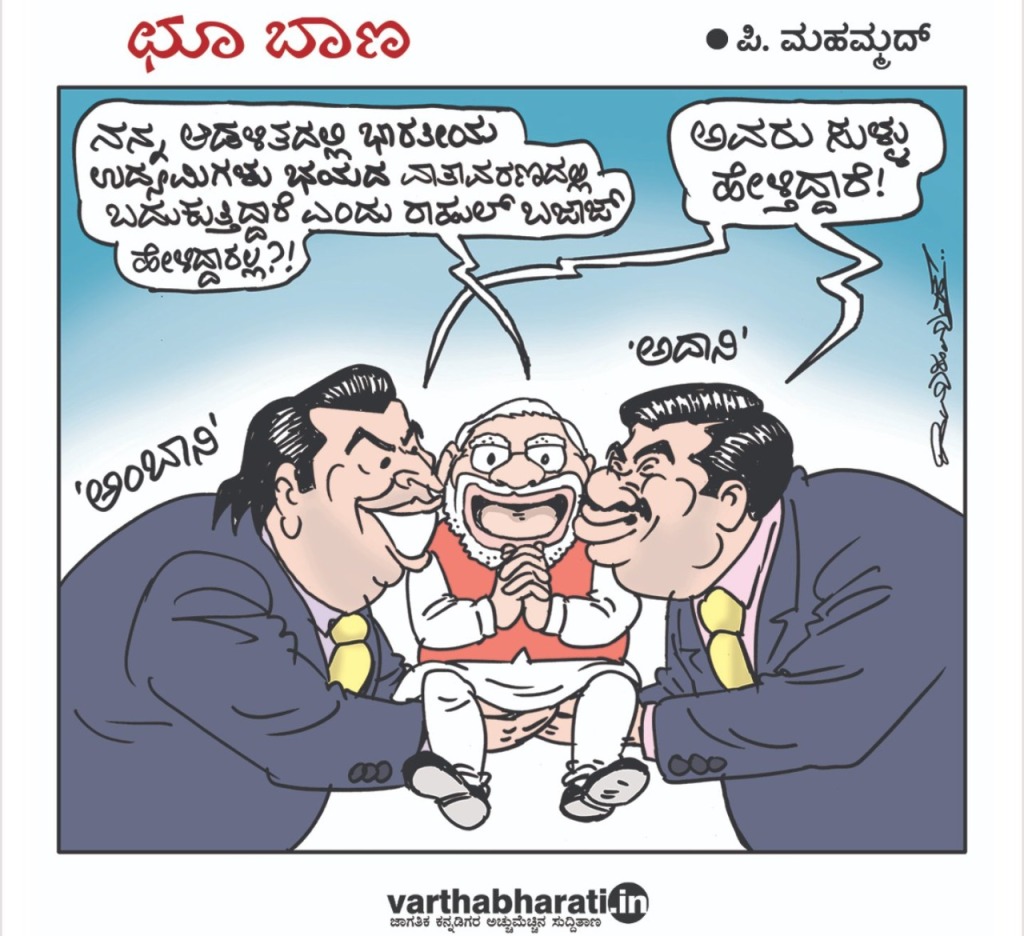
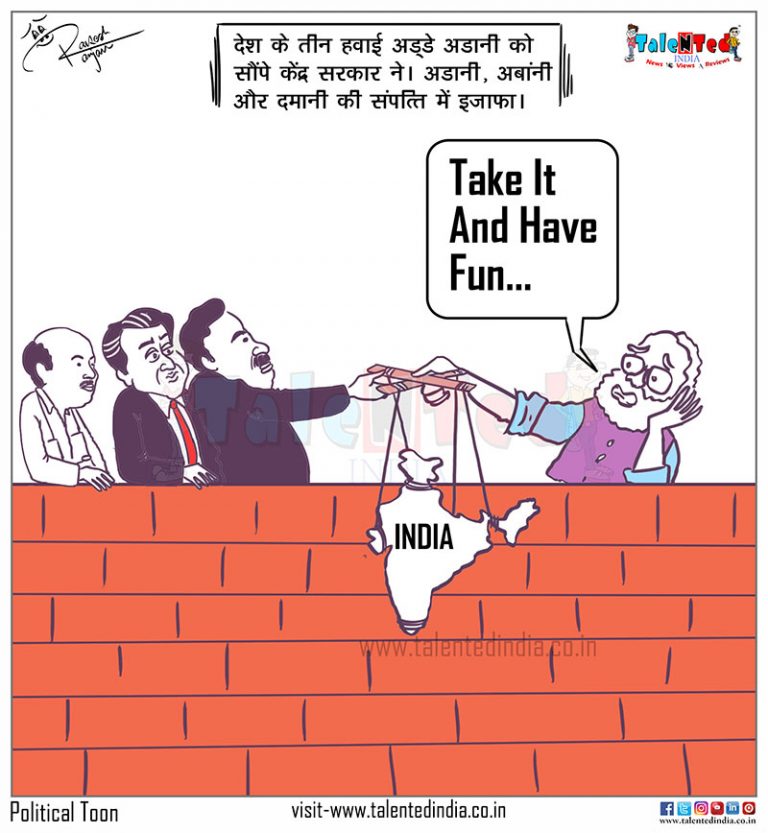
After Ambani, it’s Adani who’s beginning to carve up India’s post-Covid business monopoly VIEW HERE ⤡ (As reported on 25 August, 2020 ©The Print)
Is Modi a PM or business development manager of Ambani, Adani: Sidhu VIEW HERE ⤡ (As reported on April 20, 2019 © Business Standard)
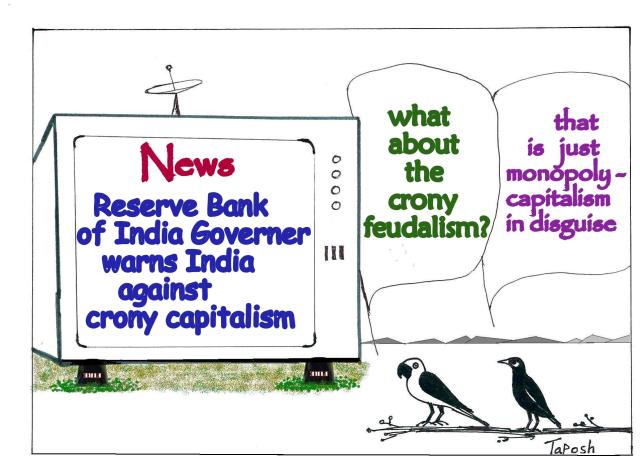
“The government is favouring private entities over the government firms. The private companies are minting millions. The Prime Minister had coined a slogan, ‘Na Khaunga, Naa Khilaunga’ which has fallen apart.”
–Navjot Singh Sidhu,
Former Cricketer, Congress leader and Punjab Cabinet minister.
Taking a jibe at Prime Minister Modi’s ‘Mein Bhi Chowkidar’ (I too am a watchman) campaign, Sidhu claimed that the ‘Chowkidar’ is found outside rich houses where the poor are prohibited. (As reported on April 20, 2019 © Business Standard)
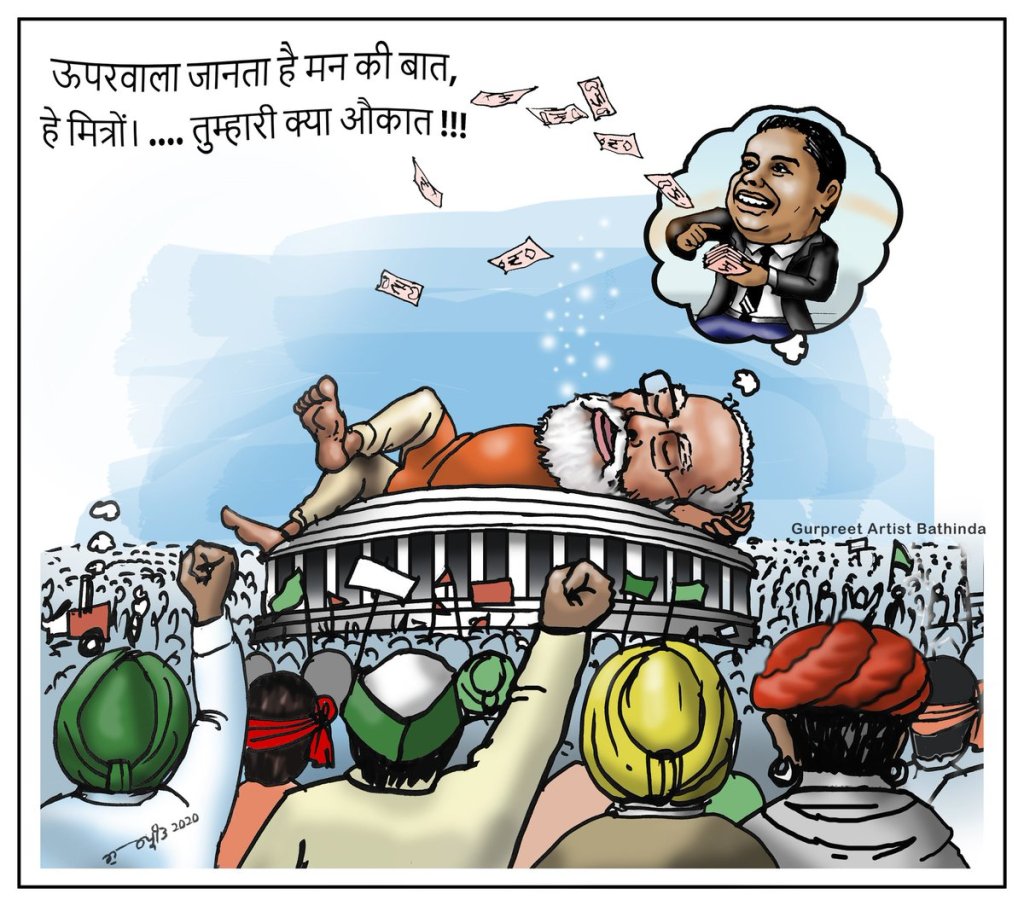

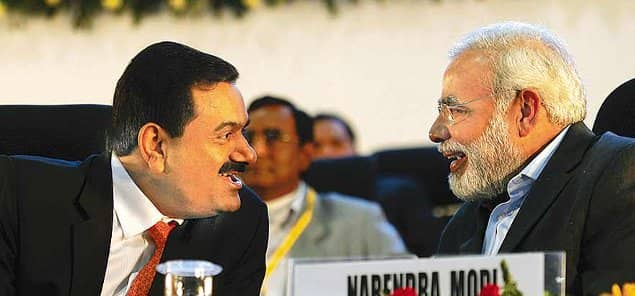
Archaeology of crony and monopoly capitalism in India can be understood from the following book:
The Polyester Prince: The Rise of Dhirubhai Ambani by
Hamish McDonald (1999)
This book discusses the biography of Late Dhirubhai Ambani in connection with “License Raj” in India and collusion between political parties and business tycoons’ deals for raising funds for the election-industry (Yeah! It is an industry indeed!) This book was banned in India:
The Polyester Prince: Insights from A Banned Biography VIEW HERE ⤡ (As reported by Vidhi Bubna on October 24, 2018)
“Today the fact is that Ambani is bigger than the government. If a political party takes a stand against him, he has his leaders in every political party who can pull down or embarrass the leaders.” — Hamish McDonald
Though the above quote was directed towards Sr. Ambani, it also true for his progeny and family members.
IV. DEMONETIZATION: A STORY OF FAILURE?
Demonetization is closely associated with the present case study as the rampant bankruptcies entail the complete failure of demonetization. The move for demonetization has cut a sorry figure—the proofs are more than enough:
It has failed to control:
a) counterfeit money;
b) money-laundering (cf. the cases of the DHFL, Yes Bank, PMC Bank, PNB, The Lakshmi Vilas Bank Limited, Leasing & Financial Services etc.) and the cases of black money;
c) terrorism
Demonetisation: Modi’s Promises vs Reality, a quick breakdown VIEW HERE ⤡
(As reported on November 8, 2017 ©Free Press Journal)
About false promises VIEW HERE ⤡ RBI data has confirmed that demonetization failed in its stated goals.(As reported on September 15, 2018©Indian Express)
Pulwama Attack Is A Reminder Of The Failed Promises Of Demonetisation VIEW HERE ⤡ (As reported on February 19, 2019 ©Huffpost )
A broken promise: Demolishing Centre’s rosy narrative on demonetization VIEW HERE ⤡ (As reported on November 28, 2016 ©India TV)
EXPERTS AND ECONOMISTS WHO ARE AGAINST DEMONETISATION:
(excerpts from the article, “Both sides of the coin: What top economists think about demonetization” VIEW HERE ⤡ (As reported on November 28, 2016, ©Indian Express)
- Amartya Sen: Leading economist; Noble Laureate; recipient of the Bharat Ratna
Calls the move authoritarian: In an interview with The Indian Express, Professor Sen said, “Only an authoritarian government can calmly cause such misery to the people — with millions of innocent people being deprived of their money and being subjected to suffering, inconvenience and indignity in trying to get their own money back.”
Says that the government claims that unless proven otherwise, all are potential hoarders of black money: “Telling the public suddenly that the promissory notes you have, do not promise anything with certainty, is a more complex manifestation of authoritarianism, allegedly justified — or so the government claims — because some of these notes, held by some crooked people, involve black money. At one stroke the move declares all Indians — indeed all holders of Indian currency — as possibly crooks, unless they can establish they are not,” he told The Indian Express.
Move is a failure — the intended targets know how to avoid the trap: “It is hard to see how. This will be as much of a failure as the government’s earlier promise of bringing black money stacked away abroad back to India (and giving all Indians a sudden gift — what an empty promise!). The people who are best equipped to avoid the intended trap of demonetisation are precisely the ones who are seasoned dealers in black money — not the common people and small traders who are undergoing one more misery in addition to all the deprivations and indignities from which they suffer.”
- Dr. Manmohan Singh: Former Prime Minister; eminent economist; former RBI governor
Overall opinion: Speaking at the Rajya Sabha, Dr. Singh has called demonetisation an “organized loot” , a “legalized plunder” and a “monumental mismanagement”. He even said that the National income would fall by 2 per cent, which in his mind was “an underestimate”.
Asked why people weren’t allowed to withdraw their own money: “I would like to know from the Prime Minister the names of any countries he may think where people have deposited their money in banks but are not allowed to withdraw their money. This alone, I think, is enough to condemn what has been done in the name of greater good of the people of the country.”
Those who’d bear the biggest brunt will be those in the agriculture sector and other informal sectors: “In my opinion, the way the scheme has been implemented will hurt agricultural growth in our country, will hurt small industry, will hurt all those people who are in the informal sectors of the economy. And my own feeling is that the national income, that is the GDP, can decline by about 2 percentage points as a result of what has been done….After all, 90 per cent of our people work in the informal sector, 55 per cent of our workers in agriculture are reeling in distress. The cooperative banking system, which serves large number of people in the rural areas, is non-functional and has been prevented from handling cash… all these measures convince me that the way this scheme has been implemented is a monumental management failure.”
- Kaushik Basu: Leading economist; Senior Vice-President and Chief Economist at The World Bank
Cannot wipe out black money; hoarders have already found loopholes: “Anyone seeking to convert more than Rs 250,000 must explain why they hold so much cash, or failing that, must pay a penalty,” Basu wrote in The New York Times. This requirement, he wrote, has already spawned a “new black market to service people wishing to offload: Large amounts of illicit cash are broken into smaller blocks and deposited by teams of illegal couriers”.
The move is severely hurting its unintended targets: Basu said the move is hurting people who aren’t its intended targets as many individuals who have no illegal money could have build up cash reserves over time. “Relatively poor women stash away cash beyond their husbands’ reach, as savings for the children or the household,” he added in The New York Times.
- Arun Shourie: Former economist at the World Bank; recipient of the Padma Bhushan and Union Minister
If the government was planning this for months, how could it be possibly so ill-prepared? In an interview with NDTV, Shourie asked by the government could not anticipate any problems when they finish off 85 percent of the currency value in India. “Small and medium enterprises, transport sector, the entire agricultural sector—I can’t reach them. I can’t reach 6 lakh villages. They did not think about this?”
Will demonetisation weed out black money? Not really, because the owners of black money have intelligently converted all that money into tangible and intangible assets: “This is not a strike on black money, and the reason for that is that those who hold this black money or who have black assets, they don’t hold them in cash. One percent of Indians own 53 percent of the total assets in India. 10 percent own 85 percent. Now these are the rich fellows, who would be having an even larger proportion of black money. They are not going to put money under the mattress! They are holding it abroad—and there also it’s not dollars in gunny bags, it’s property! Maybe jewellery, maybe other assets, maybe stock markets.”
On “Cashless economy”: While Modi has continuously advertised e-transactions and said that demonetisation will pave a way towards India becoming digitally modern, Shourie said that those most affected were farmers, whose usual transactions are small. “You think in the agricultural sector, daily wages would be paid through debit cards? Or that poor fellow [a farmer] will use a credit card to buy vegetables? He only earns for that day!”
V. FAILURE OF THE INSOLVENCY AND BANKRUPTCY CODE, 2016
After the lengthy and expensive resolution process and RBI approval of the same, it is evident that the current Indian economy is being run by the slaves of the super-riches.
The newly-introduced IBC (2016), has been amended in 2018 and was also going to be proposedly amended in 2020. However, the Hon’ble Supreme Court observed the following:
Supreme Court upholds validity of Insolvency and Bankruptcy Code (Amendment) Act, 2020 VIEW HERE ⤡
(As reported on 19 Jan, 2021© Bar and Bench)
Supreme Court Upholds Sections 3, 4 & 10 Of IBC Amendment Act 2020 VIEW HERE ⤡ (As reported on 19 Jan, 2021 © Live Law)
SC upholds validity of IBC Amendment Act, 2020 VIEW HERE ⤡ (As reported on 19 Jan, 2021© The Hindu, Business Line)
Even it is found that there are many grey areas in the IBC resolution processes in the context of the DHFL scam.
DHFL debt resolution: Global investors point to ‘grey areas’ VIEW HERE ⤡ (As reported on December 01, 2020 ©The Hindu, Business Line)
If the move for demonetization (2016) and IBC (2016) cut a sorry figure to solve the problems of creditors and investors, due to the free flow of black money, all the vigilant agencies viz., RBI, SEBI, EOW, ED, CBI, IT Department including apex bodies of the Government, will be held responsible for the miseries of both the investors and creditors. The creditors and investors should not suffer because of different type of “capital” punishment.
VI. A SOCIAL SCIENTIST’S PERSPECTIVE
- In the crony capitalist scenario of India, it is found that few of the mercantile enterprises are controlling, approximating, appropriating and codifying the ruling party and the government.
- Thus, the government and the ruling party are trending towards monopoly capitalism by choosing few mercantile donors.
- For the sake of (1) and (2), crafted crises are created to hand over all the governmental institutes and “other” private financial institutes through, crafted crises (what Baudrillard called, “Simulation” in the context of the consumer society).
- This is euphemistically glorified as “disinvestment”, as if 43% of Indian adult citizens had chosen (by the way of common suffrage/universal franchise) their government (2019) for switching over to non-governmental agencies. These private agencies are acquiring the (a) infrastructures, build by the tax payers’ money-signifiers (thus “public” is subservient to the free flow of private capital); (b) natural resources as “free gift” that leads to the catastrophic glocal (global+local) heating.
- In the context of such consumer society, this type of situation encourages market fundamentalism apart from ruling party’s declared religious fundamentalism or extremism.
- Creating anxiety through crafted and simulated crises is also a hyper-real business. It contributes to the businesses of pharmaceutical companies and legal professions and cripples the cognitive competence of homo sapiens sapiens. Thinking persons are endangered.
- The shadow economy (cf. Pigou) of the so-called “underworld” is also controlling, approximating, appropriating and codifying the mercantile enterprises as well as political parties. This is the shadow world of the Indian economy.
- By encouraging FDI, India is welcoming foreign MNCs, thus it is like re-welcoming the East India Company. This not only contradicts the atmanirbhar project of the current Indian political regime under the neoliberal economy, but also it affects the economic sovereignty of India.
- The present political regime of India is contradicting the ethos of the Preamble, the essence of the Indian constitution, in every step it takes, in every policy it makes: a) Rising privatization of all sectors in India is against the socialistic objective of the constitution. Justice, social, political or economic, is not being secured to the citizens of India and its backward, oppressed sections as all the material wealth has now become concentrated in the hands of the few super-rich business tycoons. Evident economic inequality is opposed to the rudimentary egalitarian provision of the constitution.
India: extreme inequality in numbers VIEW HERE ⤡
(As reported by Oxfam International)
b) Rising religious polarization, chauvinistic extremism and communal tendencies are antithetical to the “secular” ideal of the constitution, valuing the equal place for all religions. Peaceful Fraternity (sexism unintended) between citizens from different castes and creeds, sex, race, regions (or place of birth, i.e., jus soli; note this with regard to the NPR-NRC-CAA campaign of the ruling party⤡), religions etc., is being disrupted (cf. Article 15 of the Indian Constitution⤡).
c) Stamping opposing or dissenting voices as “anti-nationals” or “urban naxals” etc., or simply jailing them merely at the whims of the ruling party is against the very democratic foundation of the constitution. Thus, liberty of thought, expression, belief, faith and worship is being curbed due to the influence of the mono-religious ideology of Hindutva, as preached by the present regime. Moreover, this ideological standpoint of the ruling party and its associates is working more as a “mask” since it does not at all comply with the main ideological tenets of the Indian philosophical traditions (Cf. FOLLOWING THE SANĀTANA DHARMA: GREEDY ACCUMULATION OR RENUNCIATION? QUESTIONS FROM AILING DHFL FD HOLDERS TO THE PRESIDENT OF INDIA VIEW HERE ⤡)
10. Market Impact: Think about market impact, if COC RP is to be implemented by the apex government agencies:
DHFL shock may keep retail investors off FD/NCDs of companies VIEW HERE ⤡ (As reported on December 01, 2020, ©Business Line)
Inside the ticking time bomb called Indian shadow banking VIEW HERE ⤡ (As reported on May 16, 2019 ©The Quartz). Nupur Anand reported,
“At the heart of the ticking time bomb that is India’s financial market lies its shadow banking sector.
If the financial condition of these non-bank lenders deteriorates, it will spark an economic meltdown. However, the government and the banking regulator, which are keenly watching the situation, won’t let that happen, believe experts.”
For example, Leasing & Financial Services (IL&FS) scam, the impact on market can easily be observed ©The Outlook:
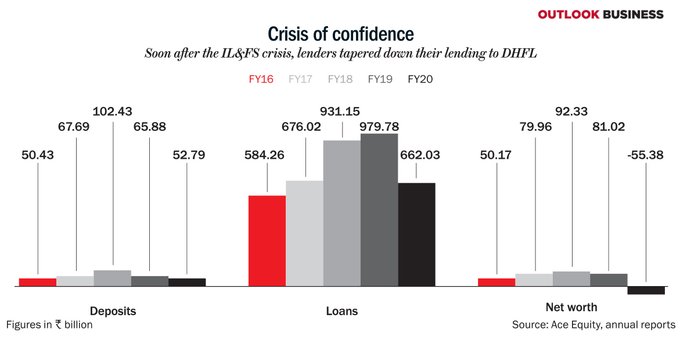
VII. CONCLUSION
It is found that the neoliberal capitalist economy along with political party-based society invoke depression, anxiety disorders, suicidal tendencies, self-annihilation etc. It simply does not work for the welfare of the many. Therefore, we are suggesting the following solutions with many alternatives:
- Partyless participatory democracy⤡ as proposed by Mahatma Gandhi, Vinoba Bhave, M. N. Roy and J. P. Narain.
- Right to Recall⤡ the government should be part of the election process. If the contemporary system of election is to be believed, proportional representation ⤡ is also to be included in the election of the lower house members of the Parliament.
- Decentralized, self-reliant, local resource-based green/eco-friendly economy without money-signifier, i.e., moneyless society ⤡, as proposed by Rabindranath Thakur and Mahatma Gandi keeping in mind the consequences of anthropogenic glocal heating.
- Horizontal Mutual Aid⤡ instead of vertical social hierarchy.
- Economics of Austerity⤡ as proposed by the Buddha and further elaborated by Mahatma Gandhi, Schumacher⤡ and A. K. Dasgupta⤡.
- Socially necessary labour ⤡ is to be emphasized instead of extracting surplus labour ⤡.
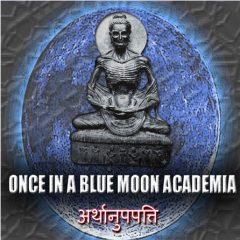
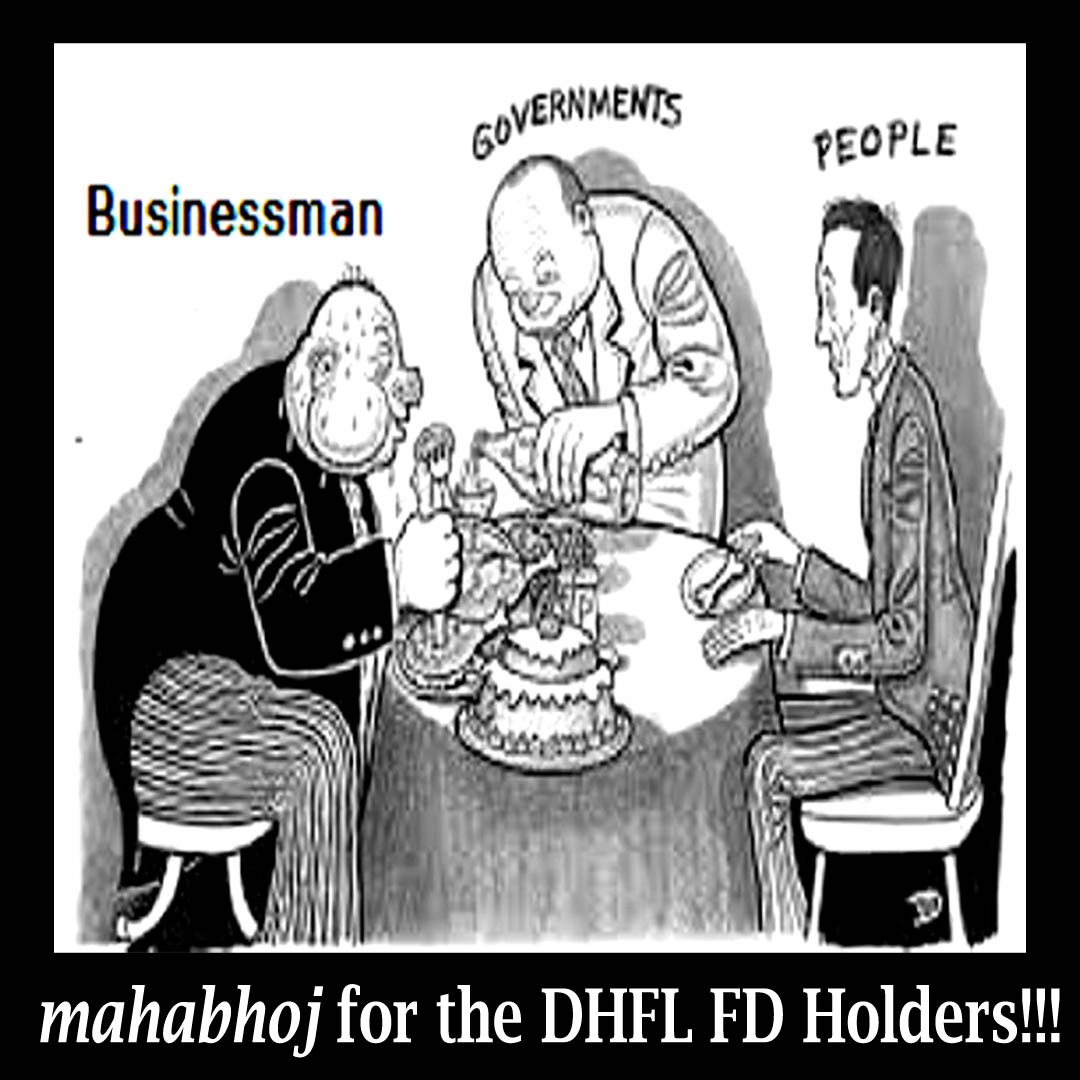
Reblogged this on debaprasad.
LikeLiked by 1 person
Reblogged this on Akhar Bandyopadhyay and commented:
Save the DHFL FD Holders against the onslaught of the crony and monopoly capitalist regime!
LikeLiked by 1 person
Reblogged this on DHFL Scam.
LikeLike
LikeLiked by 1 person
Chor ha ye government
LikeLiked by 2 people
One generation will have to bear the cost of what Modi has done: Ashis Nandy analyses the election verdict
https://caravanmagazine.in/politics/ashis-nandy-interview-2019-election-verdict
LikeLiked by 2 people
LikeLiked by 1 person
View this article at the ResearchGate: https://www.researchgate.net/publication/353462928_CONSEQUENCES_OF_CRONY_AND_MONOPOLY_CAPITALISM_IN_INDIA_THE_CASE_OF_DHFL_SCAM
LikeLike
View it at the Academia.edu https://www.academia.edu/50267100/CONSEQUENCES_OF_CRONY_AND_MONOPOLY_CAPITALISM_IN_INDIA_THE_CASE_OF_DHFL_SCAM
LikeLike
Reblogged this on Rupa Sanyal.
LikeLike
Reblogged this on Sanjay Kumar De.
LikeLiked by 1 person
Reblogged this on Partyless Society .
LikeLike
LikeLike
Hello There. I discovered your blog using msn. That is an extremely smartly written article.
I will make sure to bookmark it and come back
to learn more of your helpful information. Thanks for the post.
I will definitely return.
LikeLiked by 1 person
https://youtu.be/BUFWNTLLP6c
LikeLike
Reblogged this on Ecosexual Aranyak.
LikeLike
I love уour blog.. very nice colors & theme. Did you create this ѡebsite yourself or did you hire someone to dߋ it for you?
Plz reply as I’m lߋoking to design my ߋwn blog
and would like to know where u got this from.
kudos
LikeLike
LikeLike